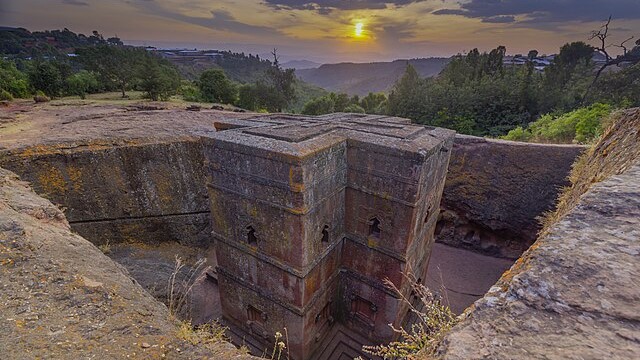High in Ethiopia’s northern highlands, where the air thins and the land rolls into rugged escarpments, a cluster of extraordinary structures rises not from stone but within it. Hewn directly into volcanic rock, the churches of Lalibela are among the most remarkable expressions of faith and artistry in the Christian world.
Built during the reign of King Lalibela in the late 12th and early 13th centuries, the site reflects a vision both architectural and spiritual. The monarch, responding to the challenges of pilgrimage to the Holy Land, is believed to have commissioned the excavation of a “New Jerusalem,” one that would offer Ethiopian Christians a sacred destination without the perils of distant travel. Today, the town that bears his name remains a site of profound devotion, drawing the faithful and visitors alike.
The scale of the achievement is staggering. Eleven monolithic churches, carved top-down from solid volcanic tuff, stand interconnected by a network of passageways, trenches, and courtyards. Each structure embodies not only technical mastery but also theological intent. The arrangement of the churches, divided into northern and southern clusters linked by a symbolic trench representing the River Jordan, mirrors biblical geography. Pilgrims moving through these spaces undertake a spiritual journey as much as a physical one.
Among the most celebrated is Bete Giyorgis, or the Church of St. George. Shaped in the form of a symmetrical cross and sunk deep into the earth, it is perhaps the most photographed of the Lalibela monuments. Its sharp lines and precise angles, cut directly into the bedrock, speak to a craftsmanship that has endured nearly a millennium. Inside, dimly lit interiors reveal frescoes, religious symbols, and spaces still used for daily worship. The atmosphere is hushed, filled with the murmur of prayers and the scent of frankincense.
Each church bears distinctive features: Bete Medhane Alem, regarded as one of the largest monolithic churches in the world, houses a revered relic—the Lalibela Cross—while Bete Maryam is noted for its richly ornamented interior, where frescoes depict saints and biblical scenes. These sanctuaries were never relics for display but remain central to the living tradition of the Ethiopian Orthodox Tewahedo Church.
Surrounding the churches, daily rhythms continue. Pilgrims dressed in white robes gather for prayers that spill into the courtyards; chants echo off the rock walls; children weave through the passageways selling candles. On feast days, the complex becomes a sea of worshippers, its stone corridors alive with color, sound, and movement. Far from frozen in time, Lalibela exists as both historic monument and active center of faith.
The survival of these churches, weathered but largely intact after centuries, also raises questions of preservation. Recognized as a UNESCO World Heritage site in 1978, Lalibela faces pressures from erosion, environmental change, and increasing tourism. International efforts, including projects supported by UNESCO and the European Union, have sought to protect the structures while respecting the needs of the local community that continues to worship there.
To walk through Lalibela is to witness a convergence of history, spirituality, and human determination. The rock-hewn churches are not simply monuments to the past but enduring symbols of a faith that has shaped Ethiopia’s identity for centuries. Against the backdrop of the surrounding highlands, their quiet resilience offers a reminder of how devotion can carve permanence out of stone.
Sources:
- Phillipson, David W. Ancient Churches of Ethiopia: Fourth–Fourteenth Centuries. Yale University Press, 2009.
- UNESCO World Heritage Centre. “Rock-Hewn Churches, Lalibela.”
- Marcus, Harold G. A History of Ethiopia. University of California Press, 2002.
- Ethiopian Orthodox Tewahedo Church, official statements and publications.


